It's never been easier to grow your business with digital advertising campaigns than it is now. People are more attached to their smartphones than ever before, and your business is more likely to be discovered online than in a store. It helps to explain why digital ad spending reached nearly $330 billion by 2020.
However, newbies to online advertising may find it intimidating. There are a lot of ad formats, performance indicators, and types of campaigns to understand. Not to forget, there are way too many acronyms to remember.
Our guide will unravel one such acronym for you: CPM. By the end of our article, you’ll be wiser when measuring the cost of your ad campaigns.
Table of contents
- What is CPM?
- Why should marketers use CPM?
- What are the differences between CPM, CPC, CPL, CPA & CPI?
- How does CPM work?
- 4 common factors affecting CPM
- 5 proven ways to reduce CPM
- Wrap up
What is CPM?
In email marketing, the cost of sending a thousand emails is referred to as CPM (cost per mile). Email service providers (ESPs) employ this price structure, also known as CPT (cost per thousand). The price covers the cost of the mail server, hosting pictures, bandwidth, bounce management, and deliverability services.

The cost per thousand emails is dependent on CPM. So, if a vendor's CPM rate is $30, sending 10,000 emails will set you back by $300.
To do the math:
(No. of Emails /1000) x CPM Rate
In digital marketing, on the other hand, an impression in CPM is the number of views/engagements an ad receives. Because impressions are such little units of measurement in marketing, they're counted by the 1,000. The lesser your CPM, the lower your ad cost, and the more revenue you generate.
To calculate it:

Related guide: 8 Types of Email Marketing Campaigns That Can Skyrocket Growth
Why should marketers use CPM?
You can use CPM to determine whether an email sponsorship/advertising opportunity is costly, inexpensive, or just right.
For marketers and advertisers, CPM is an important measure since:
it provides an accurate picture of impressions
you’ll recognize what's performing effectively with your audience;
you’ll learn which of your content and campaigns are the most popular, and
you'll have a better understanding of your brand's recognition.
However, CPM does not equal reach because impressions are not unique. After all, the same visitor could see your ad more than once. That’s why cost per click, click-through rate, and open rate are significant. You require them to assess the actual price of sponsorships.
Related guide: Email Advertising: Definition, Examples & Steps to Create Them
What are the differences between CPM, CPC, CPL, CPA & CPI?
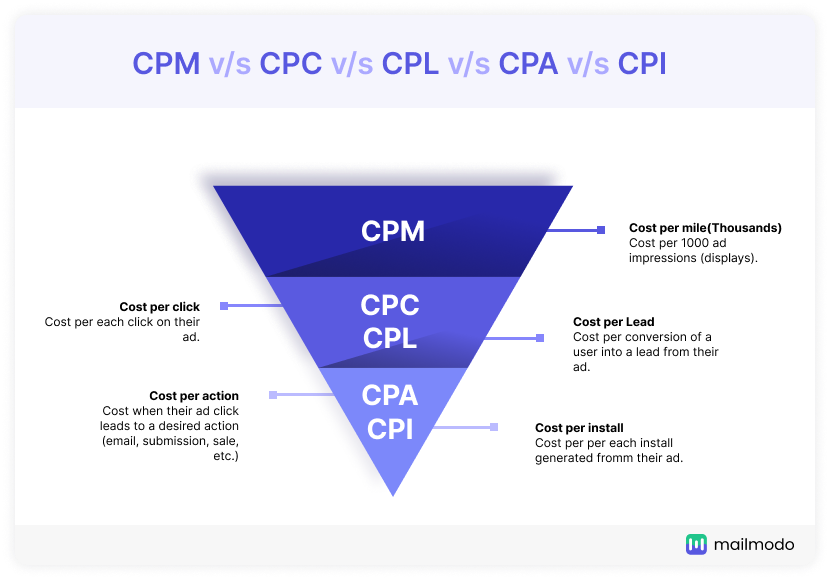
| Differences | CPM | CPC | CPL | CPA | CPI |
|---|---|---|---|---|---|
| Full form | Cost per Mile | Cost per Click | Cost per Lead | Cost per Action | Cost per Install |
| Definition | Price of 1,000 ad impressions on one webpage | Price for clicking on your ad | A pre-established price the client pays when a click converts into a lead | Marketers pay media sources for conversions that happen inside an app after an engagement with an ad | App advertisers pay each time a user installs an app from their aid |
| Upside | Cost lowers as actions are taken to go up, low risk of ad fraud | Ads are targeted and tailored, and you only pay when a visitor clicks the ad | Low-risk method to increase customer acquisition, build a database of qualified leads and make them repeat customers | Low-risk method to engage profitably with users and protect your budget from visitors who won’t convert | You only pay for visitors who convert and protect your budget in the process |
| Downside | You pay full price for the ad campaign, irrespective of its performance | Accounts for fewer impressions | Setting up a CPL campaign requires a huge investment of time and expertise | Being at the bottom of the funnel, you lose contact with your customer’s journey | A one-time installation doesn’t tell you about consumer preference, additional purchases by them, or their loyalty to the brand |
How does CPM work?
Depending on the channels you're utilizing to attract new consumers or keep existing ones, you'll need to consider a variety of KPIs.
Facebook takes the cost you spent on your campaign, divides it by the total number of impressions, and multiplies by 1,000. That’s your CPM. To find it,
- Go to the Ads Manager.
- Select "Performance and Clicks" from the Columns drop-down menu.
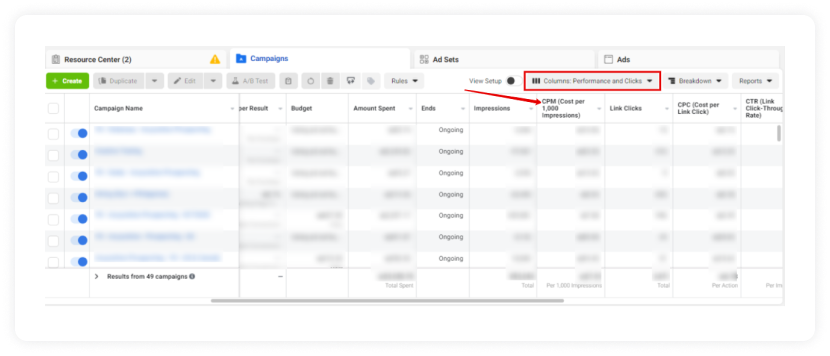
Scroll to the CPM column on the right.
Alternatively, you may use the drop-down option to select Customize Columns, check CPM and click "Apply."
The current Facebook CPM benchmarks by industry are listed below.
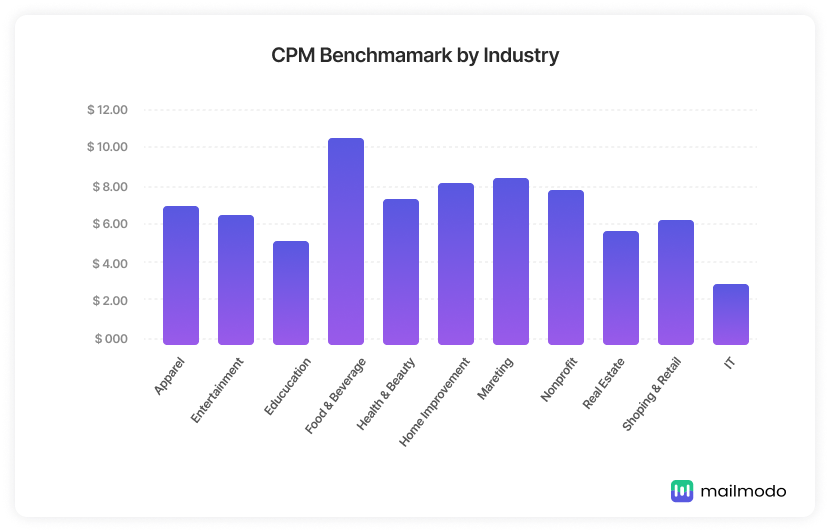
Related guide: How to Send AMP Emails From Facebook Lead Ads Using Mailmodo
Email campaigns/newsletters
The majority of email service providers use a tiered price structure. As the number of emails sent increases, the CPM rate usually decreases.
The CPM for a healthy newsletter is between $15 and $30. Your CPM can reach $100+ in rare cases when your newsletter has an audience that buys luxury products.
Some ESPs may use different price schemes. The CPM rate, for example, may be determined by the number of contacts in the client's database. Subscriptions and fixed fees are two more prominent pricing schemes.
Companies that send many emails can negotiate a lower CPM cost with their email service provider. Billing is normally done per campaign or monthly.
Related guide: Sending Interactive Email Newsletters With AMP Emails
YouTube
CPM shows how much advertisers per 1,000 views pay content creators. But those are earnings before revenue share.
YouTube takes a 45% cut. Moreover, not all views are monetized. Because some views are repeat views. Others aren't counted until they watch for at least 30 seconds. The idea is to verify that genuine people are watching and consuming your material.
To check out your YouTube CPM, go to your YouTube Studio dashboard. Then, go to analytics and see how much money you've made from your estimated monetized playbacks. The average YouTube CPM is listed below:
To check out your YouTube CPM, go to your YouTube Studio dashboard. Then, go to analytics and see how much money you've made from your estimated monetized playbacks. The average YouTube CPM is listed below:
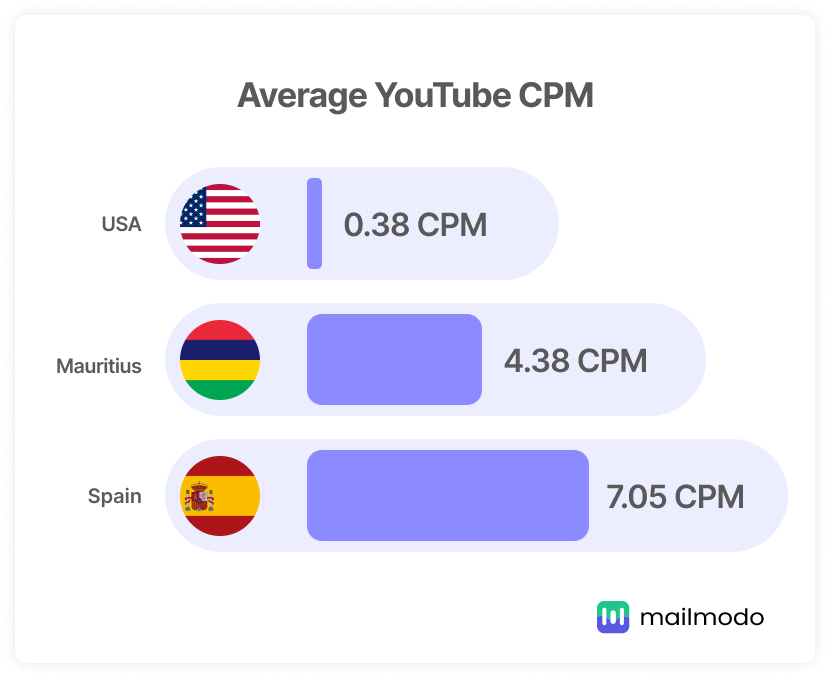
Google AdSense
Google AdSense works by finding adverts relevant to your site's content and visitors. Advertisers that wish to promote their products design and pay for the advertising. The amount you make will vary since these advertisers pay varying amounts for different advertising.
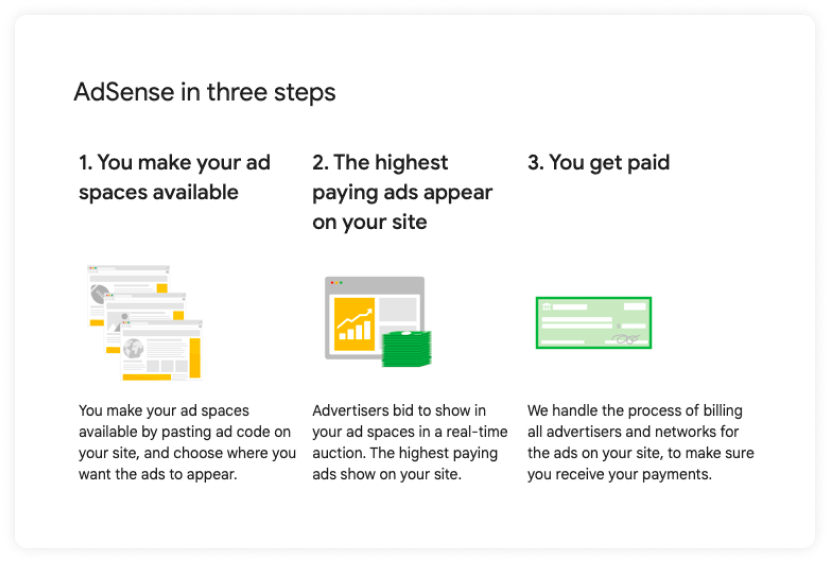
AdSense provides you with immediate access to a massive pool of advertiser demand, which means greater competition for your ad slots and more targeted advertisements.
A good CPM on Google AdSense amounts to $2.80.
4 common factors affecting CPM
The following factors may or may not be in your control when pre-determining CPM:
- Geographical location: A factor that may affect the price is the population's purchasing capacity.
- Device: Even though mobile has overtaken desktop traffic, desktop CPMs are higher due to greater conversion rates.
- Website: A high-quality website may request high rates for CPM.
- Time of the year: Holidays like Black Friday, for example, may motivate shoppers to spend more. CPMs will rise as a result of this.
5 proven ways to reduce CPM
Here are 5 foolproof ways to reduce your CPM:
1. Have a good open rate and click rate
To get 1000 impressions between $15 and $30, you'll most likely need a niche email list with high open and click rates.
Email campaigns directed to more generic audience lists will have a lower open rate. You can use Mailmodo to [increase your open rate by A/B testing, personalization, and email segmentation.
Book a free demo with us today to get a good email open rate and generate higher revenue for your business.
If you send an email to a rented email list rather than your own list, your CPM is likely to be higher. Readers are more likely to read and click through emails from writers they know and trust.
Read in detail: 12 Actionable Ways to Increase Email Open rate
2. Adjust your target audience
Social media platforms provide various tools for defining your perfect audience. You can target demographics, site visits, purchase histories, interests, purchase histories, etc. You can also use Facebook's Lookalike Audiences function to let their algorithms figure out who your target audience is.
3. Broaden your audience
Mark Woodbury of HikeSEO explains, “While increasing the size of your audience may mean showing your ads to a slightly less targeted group of people, Facebook having more options on who to show your ad to will decrease the CPM.” “However, still use targeted data from the Pixel analytics to hone in on your audience,” Taylor Lindores-Reeves of Digital Speed reiterates
4. Avoid showing ads frequently
Narrowing down your target audience is merely one aspect of the process. You should also make sure you aren't exposing your ad to those folks too often. They'll cease engaging with it if they see it too often, resulting in greater total expenditures.
5. Use A/B testing
A/B testing can assist you in figuring out which advertising work and which doesn't.
- Run two headlines at the same time to observe which one performs better. You can then pit the winner against a third headline to see if you can outperform it.
- Use A/B testing to test pictures, copy, CTAs, subject lines, etc.
- Fine-tune your advertisements over time, improving their effectiveness, raising your ranks, and decreasing your CPM.
Read in detail: A Complete Guide to Perform A/B Testing
Wrap up
Your industry's supply and demand will influence your CPM. As a result, you must understand the benchmark set for email marketing to determine whether the price you pay is reasonable. Read our guide to learn about 9 essential email marketing metrics you should be tracking in 2022.
What you should do next
Hey there, thanks for reading till the end. Here are 3 ways we can help you grow your business:
Talk to an email expert. Need someone to take your email marketing to the next level? Mailmodo’s experts are here for you. Schedule a 30-minute email consultation. Don’t worry, it’s on the house. Book a meet here.
Send emails that bring higher conversions. Mailmodo is an ESP that helps you to create and send app-like interactive emails with forms, carts, calendars, games, and other widgets for higher conversions. Sign up now and send 10k free emails/month. Sign up here.
Get smarter with our email resources. Explore all our knowledge base here and learn about email marketing, marketing strategies, best practices, growth hacks, case studies, templates, and more. Access guides here.

